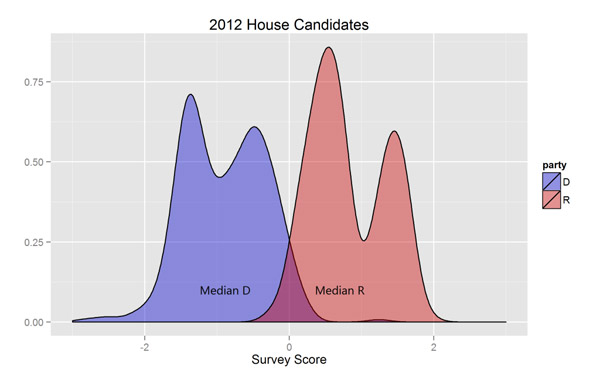Boris Shor, an associate prof at the University of Chicago's Harris School (currently at Berkeley), took an interesting look at the ideological lean of 2012 House and Senate candidates, at least so far as they're campaigning. He mined Project Vote Smart for information about this year's candidates and their stances, and plotted them across the ideological spectrum. As you'd expect, Senate candidates (who represent much broader constituencies) are much more centrist than House candidates on both sides of the isle, but both parties are "bimodal": there's a peak near the center on both sides, a lower peak towards the extremes, and a valley between the two.
For the Senate, they're near-perfect mirrors. For House, it's particularly dramatic and instructive:

Democratic House candidates are still bimodal, but there's a more diverse menu for America to choose from: a long tail from a handful of very liberal Democrats, and a less dramatic valley between more centrist Democrats and more liberal ones. To generalize Republicans, however, there are basically two flavors: centrist and conservative. Shor writes:
What could be causing this? Perhaps new electoral forces like the Tea Party on the right and Occupy Wall Street on the left are forcing candidates to pay lip service to dogma in some new way. And what happens after the election? Will this internal schism go away? Or does this presage a new battle between liberal liberals and liberal moderates, and between conservative conservatives and conservative moderates?
Your guess is as good as mine, though. Any ideas?
The Democratic liberal peak is a bit of surprise to me, but I think it's this (and not Occupy): Democrats in the House cluster in urban areas; the highest quartile of congressional districts by density are almost all Democratic. Urban areas tend to be more liberal, so Democratic house races will always have a reasonably high baseline of liberal-Democratic candidates. But what you buy is not always what you get: "Measures of elected legislators’ voting behavior in office generally show far fewer moderates. This suggests that, either by design or due to pressures beyond their control, candidates often campaign as moderates and govern as partisans."



